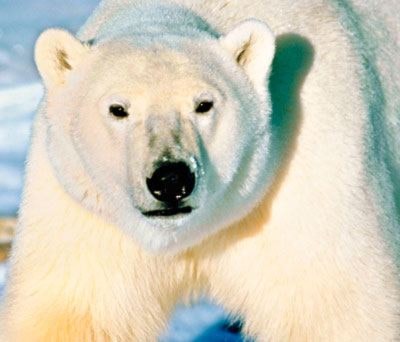Polar bears and other members of the animal kingdom aren’t protected in the Yukon, says a member of the David Suzuki Foundation.
The environmental organization has just completed a study — Canada’s Polar Bears, Falling Through the Cracks — and feels the Yukon’s animal-protection regime is lacking, said Rachel Plotkin, a biodiversity policy analyst for the foundation.
The report shows a warming climate and melting ice caps are leaving the polar bears’ habitat at risk, yet few jurisdictions will list the bear as a species at risk and no governments protect it, she said.
“Right now, the polar bear receives zero legislative protection at the national level.”
Out of the seven Canadian provinces and territories that have polar bears — Yukon, NWT, Nunavut, Manitoba, Ontario, Quebec, and Newfoundland and Labrador — only Ontario and Newfoundland recognize the bears’ plight, said Plotkin.
Canada has 13 of the world’s 19 polar bear populations, including the bears the Yukon shares with Alaska and NWT, which are located along the territory’s northern shoreline.
The Yukon is lagging behind many other areas in Canada in that it has no stand-alone endangered species legislation, said Plotkin.
“We would certainly call on the government to implement stand-alone endangered species legislation.
“That has a science-based listing process, that identifies critical habitat and maps it and ensures that it’s maintained.
“I’ve heard several times from people in the Yukon that it’s imminent, but I’ve never seen anything, and I’ve been working on this file for six years.”
The foundation would like to see the Yukon government complete land-planning exercises in areas such as the Bonnet Plume before allowing industrial activity to take place, said Plotkin.
“What the conservation community asks is appropriate land-use planning and conservation land-use planning happens prior to development,” she said.
“What that means is before you go and open things up for development, is there sufficient land set aside for conservation.”
“Strong endangered-species laws and protected areas are two critical tools Canada has to recover and protect species at risk, like the polar bear.”
There are some areas with polar bears that have taken steps toward proper land planning and endangered species protection, according to the foundation’s report.
Ontario has a scientifically based endangered species listing process through a committee appointed by its lieutenant governor.
Ontario’s Endangered Species Act governs recovery strategies, which must include identification of the species’ habitat needs, a description of threats to its survival and recovery, recommendations for recovery, protection objectives and how those objectives will be achieved, according to the foundation’s report.
Quebec has a discretionary listing of endangered species under its Act Respecting Threatened or Vulnerable Species, which covers a small portion of the “extensive” list of plants and animals listed as threatened or vulnerable.
Quebec has no legal requirement to produce recovery plans, but a non-binding regulation calls the province to produce plans for listed species.
Manitoba’s Endangered Species Act allows political discretion to determine whether species are listed as threatened, endangered or extinct.
Manitoba’s act does not require recovery planning or implementation.
Newfoundland and Labrador’s Endangered Species Act has a discretionary listing process that gives cabinet 90 days to respond to listing recommendations and has 24 species, including the polar bear, listed as endangered, threatened or vulnerable.
Newfoundland law requires the release of a recovery plan within one year of a species being designated endangered, two years for animals that are listed as threatened, and three years for vulnerable species.
It is prohibited to “disturb, harass, injure or kill” threatened or endangered species or disturb or destroy their habitat in Newfoundland, according to the Suzuki report.
Nunavut’s Wildlife Act aims to base listing on a combination of scientific information and traditional knowledge, according to the report.
Members of the public can seek a listing and recovery plans must be prepared within two years of threatened or endangered species being recognized.
Recovery policies must identify the species’ critical habitat in Nunavut, according to the report.
The NWT has proposed legislation on the management of species and calls for an advisory committee to make recommendations based on science and traditional knowledge.
The advisory committee’s recommendations would, if the legislation were implemented, be forwarded to authorities with future action considered.
NWT’s draft legislation states that recovery strategies would be required for species as endangered, in one year, and two years if listed as threatened, according to the report.
Yukon has no stand-alone species at risk legislation and has no formal listing process for species at risk under the Wildlife Act, according to the report.
The Yukon’s Parks and Land Certainty Act permits, but does not require, protecting areas important for rare or endangered plants or wildlife.
“The Yukon has no laws regarding endangered species, but the Wildlife Act prevents elk, cougar, gyrfalcon, peregrine falcon and trumpeter swan from being hunted, harassed,” states the report.
The Suzuki report is incorrect when it states Yukon polar bears are not protected, said Dennis Senger, spokesperson for Yukon’s Environment department.
“The hunting of polar bears is prohibited by section six of the Wildlife Act. The fine is up to $50,000 and one year in jail,” he said.
“The fine and amount of jail time can double if the animal was hunted for commercial purposes.”
While there is no hunting, the Inuvialuit harvesting rights are subject to quotas, he said.
And, while it’s true, the Yukon does not have any stand-alone endangered species legislation; the Yukon is working on it, said Senger.
“It was announced Wednesday, in the legislative assembly, in our supplementary budget package, that we would be working on the legal review to bring forward new legislation,” he said.
“We will be in discussions with the federal government, First Nations and other agencies to work out the details on how and when we might proceed on this.”
The Yukon government is also working with Ottawa on recovery programs for threatened species and species of special concern, he said.
